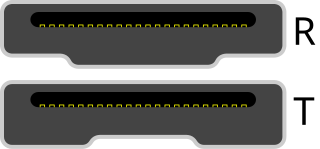
Digital Visual Interface (DVI) is a video display interface developed by the Digital Display Working Group (DDWG). The digital interface is used to connect a video source, such as a video display controller, to a display device, such as a computer monitor. It was developed with the intention of creating an industry standard for the transfer of uncompressed digital video content.

Low-voltage differential signaling (LVDS), also known as TIA/EIA-644, is a technical standard that specifies electrical characteristics of a differential, serial signaling standard. LVDS operates at low power and can run at very high speeds using inexpensive twisted-pair copper cables. LVDS is a physical layer specification only; many data communication standards and applications use it and add a data link layer as defined in the OSI model on top of it.

High-Definition Multimedia Interface (HDMI) is a proprietary audio/video interface for transmitting uncompressed video data and compressed or uncompressed digital audio data from an HDMI-compliant source device, such as a display controller, to a compatible computer monitor, video projector, digital television, or digital audio device. HDMI is a digital replacement for analog video standards.

Transition-minimized differential signaling (TMDS), a technology for transmitting high-speed serial data, is used by the DVI and HDMI video interfaces, as well as by other digital communication interfaces.

Current mode logic (CML), or source-coupled logic (SCL), is a digital design style used both for logic gates and for board-level digital signaling of digital data.
SPI-4.2 is a version of the System Packet Interface published by the Optical Internetworking Forum. It was designed to be used in systems that support OC-192 SONET interfaces and is sometimes used in 10 Gigabit Ethernet based systems.

DisplayPort (DP) is a digital display interface developed by a consortium of PC and chip manufacturers and standardized by the Video Electronics Standards Association (VESA). It is primarily used to connect a video source to a display device such as a computer monitor. It can also carry audio, USB, and other forms of data.

A video display controller or VDC is an integrated circuit which is the main component in a video-signal generator, a device responsible for the production of a TV video signal in a computing or game system. Some VDCs also generate an audio signal, but that is not their main function.

Unified Display Interface (UDI) was a digital video interface specification released in 2006 which was based on Digital Visual Interface (DVI). It was intended to be a lower cost implementation while providing compatibility with existing High-Definition Multimedia Interface (HDMI) and DVI displays. Unlike HDMI, which is aimed at high-definition multimedia consumer electronics devices such as television monitors and DVD players, UDI was specifically targeted towards computer monitor and video card manufacturers and did not support the transfer of audio data. A contemporary rival standard, DisplayPort, gained significant industry support starting in 2007 and the UDI specification was abandoned shortly thereafter without having released any products.

OpenLDI is a high-bandwidth digital-video interface standard for connecting graphics/video processors to flat panel LCD monitors. Even though the promoter’s group originally designed it for the desktop computer to monitor application, the majority of applications today are industrial display connections. For example, displays in medical imaging, machine vision, and construction equipment use the OpenLDI chipsets.

Parallel SCSI is the earliest of the interface implementations in the SCSI family. SPI is a parallel bus; there is one set of electrical connections stretching from one end of the SCSI bus to the other. A SCSI device attaches to the bus but does not interrupt it. Both ends of the bus must be terminated.
Serial Digital Video Out (SDVO) is a proprietary Intel technology introduced with their 9xx-series of motherboard chipsets.
Camera Link is a serial communication protocol standard designed for camera interface applications based on the National Semiconductor interface Channel-link. It was designed for the purpose of standardizing scientific and industrial video products including cameras, cables and frame grabbers. The standard is maintained and administered by the Automated Imaging Association or AIA, the global machine vision industry's trade group.

The Display Serial Interface (DSI) is a specification by the Mobile Industry Processor Interface (MIPI) Alliance aimed at reducing the cost of display controllers in a mobile device. It is commonly targeted at LCD and similar display technologies. It defines a serial bus and a communication protocol between the host, the source of the image data, and the device which is the destination. The interface is closed source, which means that the specification of the interface is not open to the public. The maintenance of the interface is the responsibility of the MIPI Alliance. Only legal entities can be members. These members or the persons commissioned and approved by them have access to the specification in order to use it in their possible applications.
Channel-Link (C-Link) by National Semiconductor is a high-speed interface for cost-effectively transferring data at rates from 250 megabits/second to 6.4 gigabits/second over backplanes or cables. National Semiconductor introduced the first Channel-Link chipsets in the late 1990s to provide an alternative to continually widening data buses to get higher throughput.
Automotive pixel link, or APIX, is a serial high speed Gigabit Multichannel link to interconnect displays, cameras and control units over one single cable targeting automotive applications. APIX2 transmits up to two independent HR real time video channels plus bidirectional protected data communication with Ethernet, SPI, I2C including 8 channels for audio.
V-by-One HS is an electrical digital signaling standard that can run at faster speeds over inexpensive twisted-pair copper cables than Low-voltage differential signaling, or LVDS. It was originally developed by THine Electronics, Inc. in 2007 for high-definition televisions but since 2010 V-by-One HS has been widely adopted in various markets such as document processing, automotive infotainment systems, industrial cameras and machine vision, robotics and amusement equipments.

THine Electronics Incorporated is a Japanese fabless LSI maker that provides mixed signal LSI and analog technologies, headquartered in Tokyo, Japan. THine Electronics also has subsidiaries in Seoul, Korea and Taipei, Taiwan. Some of THine’s products have the most market shares in the world because of technical advantages. Its technologies include high-speed interfaces such as V-by-One HS, LVDS, timing controller, analog-to-digital converter (ADC), image signal processor (ISP), and power management in smart phone, tablets, flat screen televisions, LCD monitors, projectors, document processing, amusement, security systems, and automotive markets.

The OPEN Alliance is a non-profit, special interest group (SIG) of mainly automotive industry and technology providers collaborating to encourage wide scale adoption of Ethernet-based communication as the standard in automotive networking applications.
Valens Semiconductor (Valens) is an Israeli fabless manufacturing company providing semiconductors for the automotive and audio-video industries. Valens provides semiconductor products for the distribution of uncompressed ultra-high-definition (UHD) multimedia content and in-vehicle connectivity applications. The company is a member of the MIPI Alliance and developed the first-to-market chipset that is compliant with the MIPI A-PHY standard. Valens invented the technology behind the HDBaseT standard and is a co-founder of the HDBaseT Alliance.















